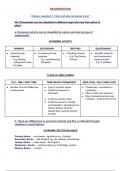REGENERATION
Enquiry question 1: How and why do places vary?
4A.1 Economies can be classified in different ways and vary from place to
place.
a. Economic activity can be classified by sector and also by type of
employment.
ECONOMIC ACTIVITY
PRIMARY SECONDARY TERTIARY QUATERNARY
● Extracting raw ● Processing of raw ● Providing services ● Scientific research
materials materials ○ E.g. Taxi Drivers, and development
○ E.g. farming, ○ E.g. manufacturing Doctors based services
cutting down trees the paper ○ E.g. IT software
for paper
TYPES OF EMPLOYMENT
FULL TIME / PART TIME TEMPORARY/ PERMANENT EMPLOYED / SELF EMPLOYED
● Number of hours fulfilled per ● Type of contract signed ● Freelancers, consultants or
working week ● Could be long-term or contractors
short-term ● May run their own business
● May incorporate as their own
● Could be at short notice company - small amount of tax
● Could be seasonal: Usually
concentrated in agricultural and
tourism sectors (summer
harvest time, summer tourism
in LDN)
b. There are differences in economic activity and this is reflected through
variation in social factors
ECONOMIC SECTOR BALANCE
Primary Sector → rural areas - agriculture e.g. Cumbria
Secondary Sector → NE England e.g. car makers in Scunthorpe
Tertiary Sector → urban areas - SE England
Quaternary Sector → science parks e.g. Cambridge, London
Quinary Sector → London
, SOCIAL FACTORS
HEALTH LIFE EXPECTANCY EDUCATION LEVELS
Those in primary employment have ● ⇒ the average age a person is ● Unequal
a higher risk of poorer health and expected to live on the day ● Outcomes measured by
mortality they’re born examination results,
● Exposure to carcinogens, ● Varies across regions correlated with income levels
causing cancers ● 2011 UK Census - higher in the ● Private school vs state
south than the north school
Food deserts ⇒ places that have a
higher incidence of fast-food outlets Factors:
● Higher death rates → less ● Gender
access to fresh food, more ● Income, Occupation
access to unhealthy food ● Education
● E.g. New Orleans ● Lifestyle
● Access to healthcare
c. The inequalities in pay levels across economic sectors and in different types
of employment are reflected in quality of life indices
IMD MEASURES:
Income Employment
Education and training Health deprivation
Crime Access to housing
Environment
4A.2 Places have changed their function and characteristics over time.
a. Over time, places have changed their functions and demographic
characteristics
THE FUNCTION OF PLACES
ADMINISTRATIVE COMMERCIAL RETAIL INDUSTRIAL
● Council offices, ● Offices for service ● Grocery stores, ● Factories,
schools, clinics, industry firms, legal malls, clothing warehouses and
hospitals services and stores distribution centres
accountants ● E.g. Amazon
● E.g. Grant Thornton
, DEMOGRAPHIC CHARACTERISTICS
GENTRIFICATION AGE STRUCTURE ETHNIC COMPOSITION
● ⇒ process that sees ● UK: life expectancy has ● Variety depends
low-income groups displaced increased in the last 50 years ● London - multicultural hub,
by affluent people who usually ● Rural areas: higher percentage different ethnicities and
have professional or of elderly people compared to nationalities mixing together
managerial occupations urban areas
● Associated with the
improvements in housing
quality
● E.g. Shoreditch, London
b. Reason for changes in a place might be explained by physical factors,
accessibility and connectedness, historical development and the role of local
and national planning
REASON FOR CHANGES
PHYSICAL FACTORS ● Coastal Erosion → e.g. Happisburgh: 250m land lost over 250 years
● Weather → flooding changes a place e.g. Shrewsbury needs flood defences
● Climate Change → influences policies and land use e.g. Cornwall: Solar Farms
ACCESSIBILITY & ● Transport → development have changed important of diff towns
CONNECTIONS ● Connection → increases tourism and migration
● Broadband → increases communication
HISTORICAL ● Totnes: transition towns, local currency helping businesses to grow, encouraging
DEVELOPMENT investment
● London Dockland: changed to economic hub
● Changes in consumer trends - decline in high streets - greater use of online
shopping
LOCAL & NATIONAL ● Wanting to expand urban areas (increasing homes, railways) overrunning rural
PLANNING villages e.g. Bicester Outlet Village
● Negative Impacts of Expansion → increasing house prices and congestion
c. Change can be measured using employment trends, demographic changes,
land use changes and levels of deprivation
MEASURING CHANGES IN PLACES
● Stage of place’s economic development (Use the index IMD)
● Employment Structure (ONS provides data on employment trends over time)
● Demographic Characteristics (ONS provides data on demographic trends over time)
● Land Usage (can carry out land-use mapping, compare it with old maps)





